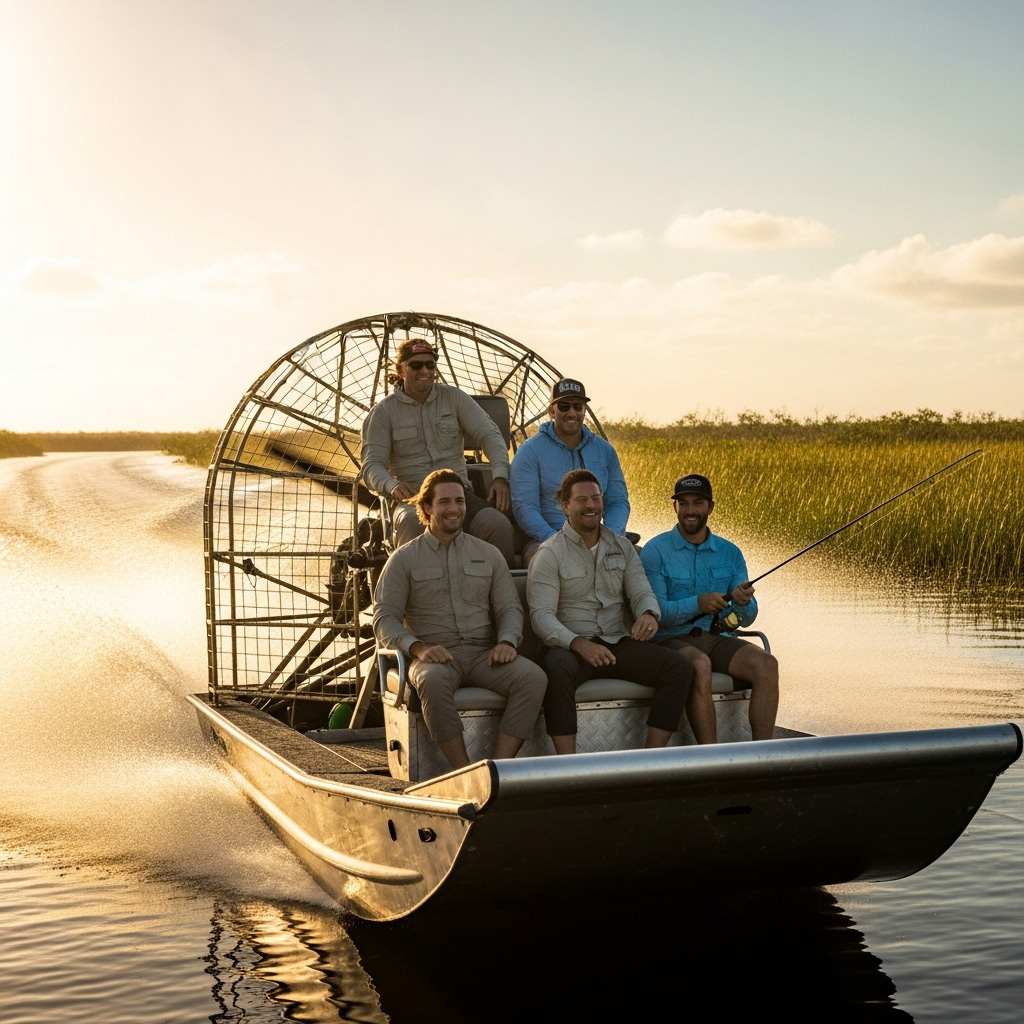Exploring the waters near Steinhatchee and Lamont offers a rare glimpse of Florida’s Big Bend in its most untouched form. The rivers, marsh flats, and tidal creeks here wind through an ecosystem that feels worlds away from the usual busy fishing spots.
Airboat fishing charters can provide access to these remote areas, gliding across shallow flats and weaving through narrow waterways where traditional boats cannot follow. From the first roar of the propeller to the smooth lift of the hull skimming the surface, every airboat ride through this part of the Big Bend feels like a backstage pass to a wilder Florida.
The trip begins in water tinted with tannins from ancient cypress roots and quickly opens into sunlit marshland alive with herons, roseate spoonbills, and the occasional alligator cutting a wake through the grass. Beneath the surface, redfish and trout cruise along oyster bars that only locals and fishing guides know how to reach. In winter, the crisp air and still mornings create mirrorlike reflections across the flats. By summer, the horizon shimmers in the heat as schools of mullet scatter ahead of the fan’s wake.
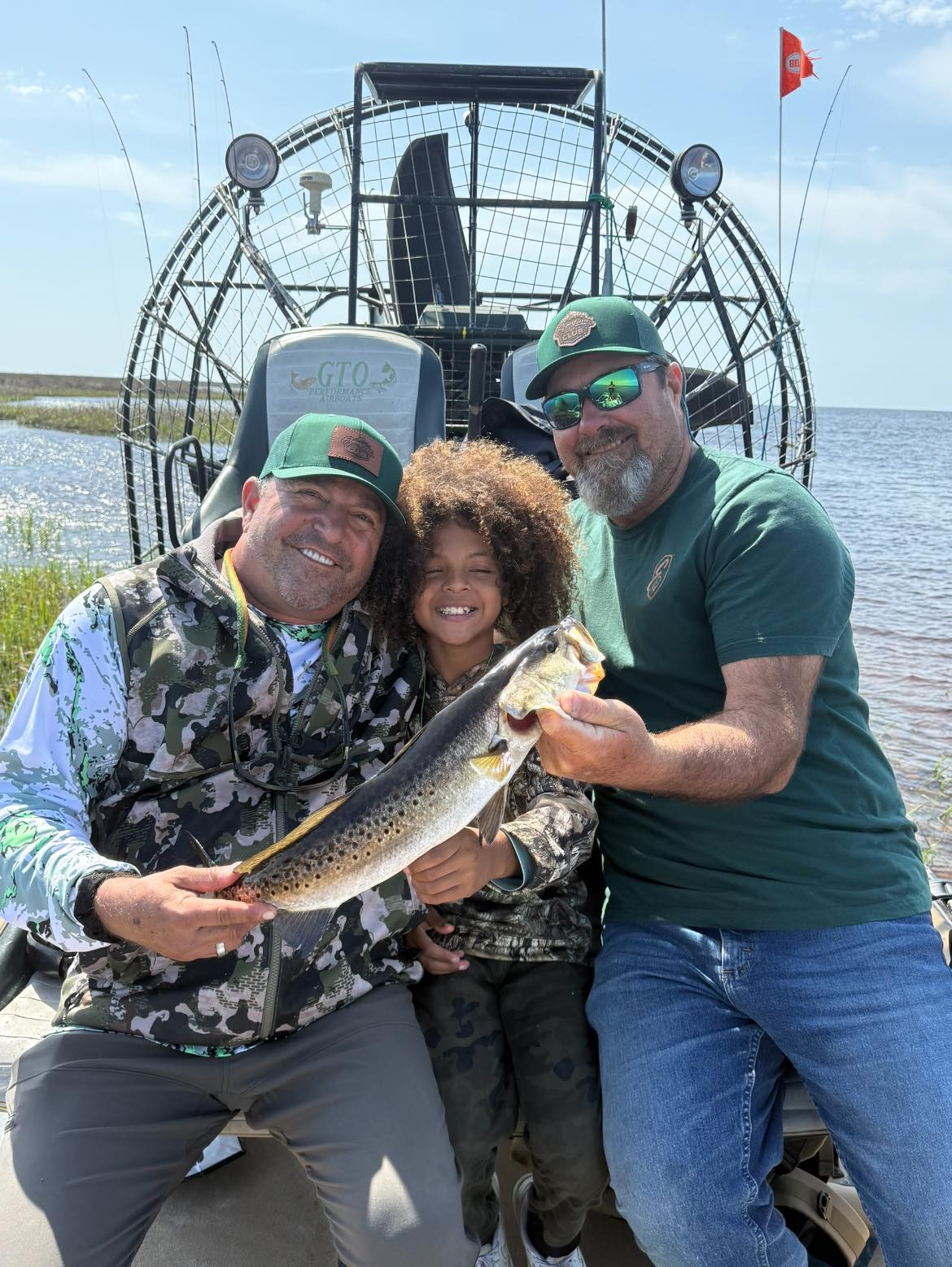
Whether the day’s goal is to sight-cast for tailing fish or simply to explore backcountry bends that haven’t changed in generations, there’s a quiet awe in realizing how vast and unspoiled this stretch of coastline remains. Each turn reveals something new—freshwater springs bubbling into salt creeks, old pilings swallowed by mangroves, and channels so tight you can reach out and brush the sawgrass.
Fishing the Seasons in the Econfina Region
The Big Bend fishing calendar is always shifting, with each season presenting its own opportunities. When low tides drain the flats and strand traditional skiffs, an airboat can still slip over oyster bars and glide into hidden lagoons where redfish tail in the shallows. During cooler months, that means you get access to some much warmer backwaters where the fish gather in thick schools, and in summer it allows early-morning runs deep into grass-lined creeks before the midday heat sets in.
- Spring brings warming waters and schools of trout moving across the grass flats. Redfish feed aggressively in the creeks, making them prime targets for airboat access.
- Summer offers a blend of inshore fishing and scalloping. Many fishermen pair morning fishing trips with afternoons gathering scallops in the clear shallows around Steinhatchee.
- Fall is one of the most productive periods, with redfish gathering in larger numbers and speckled trout feeding hard before winter.
- Winter cools the water, concentrating fish in deeper holes and channels that fan boats can still reach when tides run low.
Because airboat trips are not limited by depth, fishermen can target areas at times of year when tides would otherwise prevent boat access. This opens up more consistent fishing opportunities across the seasons.
Target Species in Remote Waters
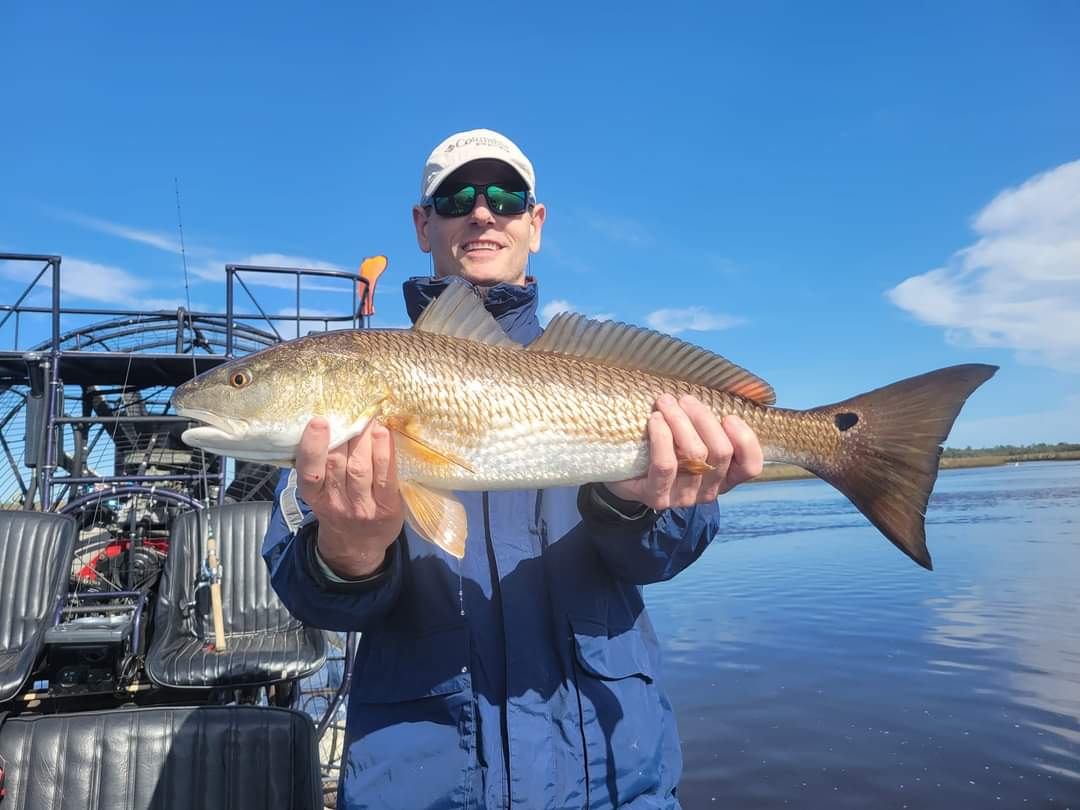
These creeks and flats hold a wide variety of inshore species. Some of the most common catches include:
- Redfish – Often tailing in shallow grass or cruising along the marsh edges. When the tide floods the spartina, you’ll see their copper backs shimmer just beneath the surface as they root for crabs and shrimp. A soft cast with a weedless spoon or shrimp imitation dropped ahead of the wake can draw a strike so sudden it rattles the hull. These fish patrol the same skinny water that airboats were built to reach—places where prop boats run dry before daylight.
- Speckled Trout – Found on grass flats, sandy potholes, and creek mouths. They ambush bait on the falling tide, especially where clear freshwater meets salt. A slow drift across the flats at first light, tossing soft plastics or live shrimp, will often light up the rods. On colder mornings, they’ll hold in deeper bends and holes—spots airboats can ease into long after the tide has run out.
- Black Drum – Feeding on crustaceans in shallow mudflats. You’ll hear them before you see them sometimes, that low drumming echoing through the hull as they tail in inches of water. They crush crabs and shrimp in the soft bottom, leaving pockmarks where they’ve been rooting. A well-placed bait on a light jig head turns that subtle thump into a slow, steady pull that never fails to test your line.
- Sheepshead – Around oyster bars and hard bottom structure. These guys pick barnacles and small crabs from shell piles, requiring patience and sharp timing to hook. They love structure near the creek mouths, especially when the water clears on an outgoing tide. Guides who know the rhythm of the marsh can park an airboat just outside the flow and let you drop baits into the strike zone with precision.
- Occasional Tarpon or Snook – During warmer months in select backwaters. When the humidity thickens and the mullet run strong, silver flashes start rolling at the edges of the flats. Tarpon sweep through the channels at dawn, and snook lurk beneath overhangs where the freshwater springs mix with the tide. Hook into one in these narrow creeks and you’ll understand why fishermen chase the Big Bend’s hidden giants long after most folks head home.
The draw of airboat fishing is the chance to quietly approach fish in waters that rarely see pressure. For fishermen who appreciate sight-fishing opportunities and wild, untouched backdrops, these trips deliver both.
Weather, Tides, and the Airboat Advantage
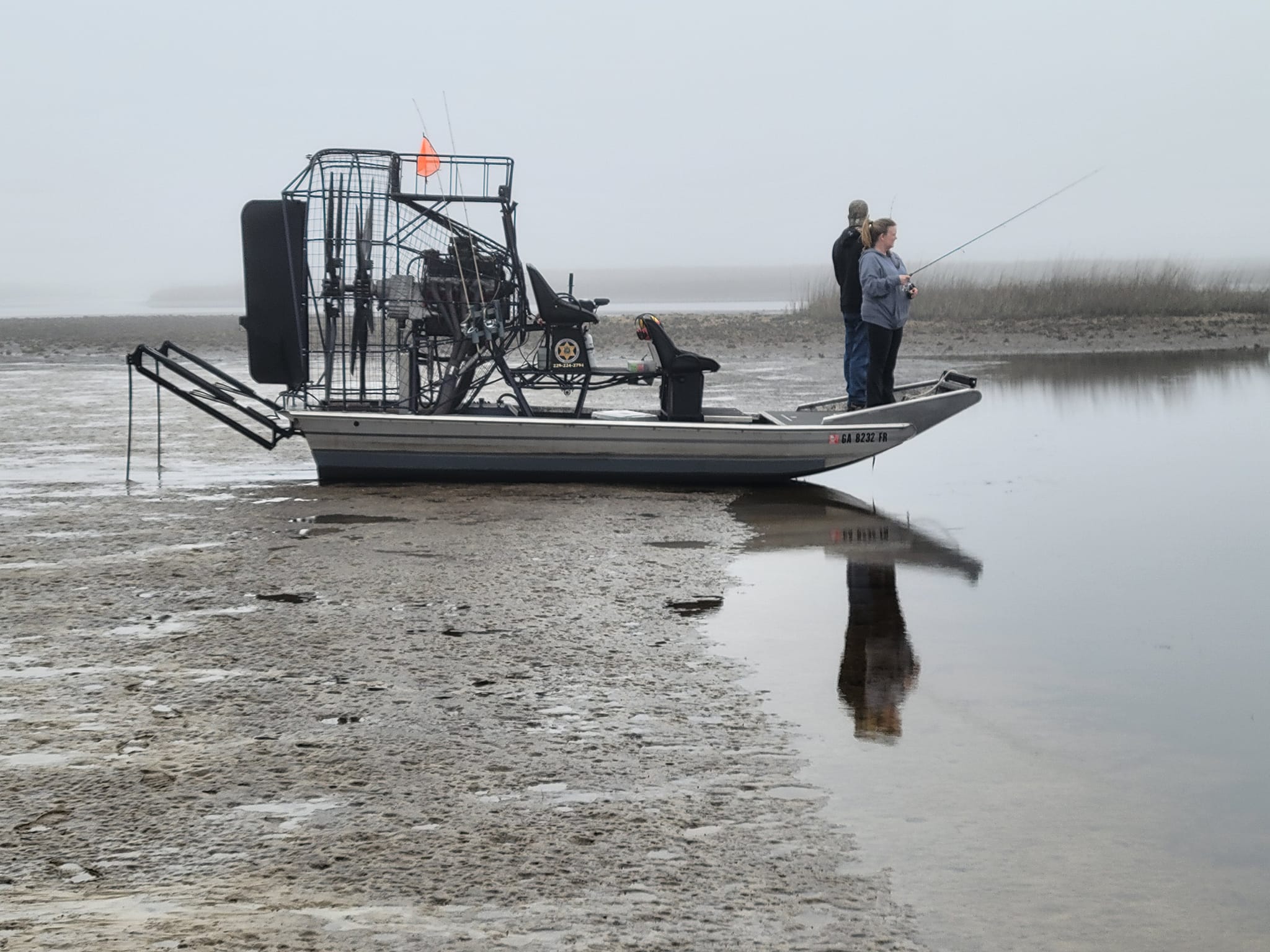
The weather is always going to play a big part in fishing near Steinhatchee and Lamont. Summer brings hot afternoons, making morning or evening runs the most comfortable. In the winter, cooler mornings are followed by warmer mid-day windows that often trigger feeding activity. Tides shift the game even further, with high tides pushing fish into the marshes and low tides concentrating them in the channels.
When that tide starts moving, the whole marsh comes alive. One minute it’s nothing but grass and mud, then the water creeps in and turns it into a sheet of silver with bait jumping everywhere. Reds push up so shallow their backs break the surface, sliding through the grass like they own the place. Drop back a few hours, though, and that same spot’s bone dry—fish packed into narrow cuts where the current pulls shrimp and crabs right to them.
The airboat changes the equation. Traditional skiffs and bay boats are limited by water depth, but these grass gliders can slide across inches of water or even mud flats when necessary.
Once that tide dumps out, most boats are stuck waiting for the water to come back, but good airboat fishing guides know how to read the slicks, the shine of wet mud, and the faintest trickle cutting through a flat. They’ll ease across spots that look bone dry, chasing that last bit of flow where fish hole up. You can smell the salt and marsh grass mixing with the churn from the prop, feel that light mist on your face as the boat skips over oyster shell and soft muck—no waiting on the tide, no turning back early.
What to Expect on a Trip
Every airboat fishing charter is led by a licensed captain familiar with the Econfina ecosystem. Trips typically run half a day, with rods, reels, tackle, and all required safety gear included. A cooler stocked with cold waters is provided to keep things comfortable.
For those who want to customize their day, several options are available:
- Professional photography sessions to capture the action.
- Combo trips that mix fishing with a nature tour.
- Evening and sunset runs, where the marsh comes alive with birds and wildlife.
These details are designed to keep the experience simple and enjoyable so fishermen can focus on the thrill of the catch and the beauty of the setting.
Tips for Airboat Fishing Trips
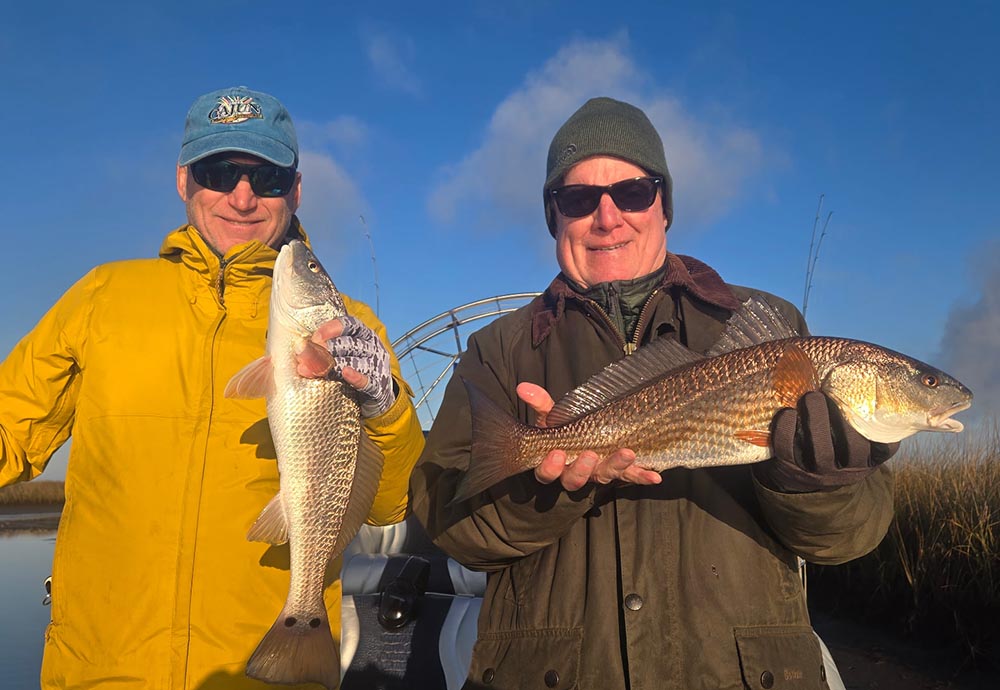
Fishing along the Big Bend gets better the more you know how to work with the conditions. Every airboat fishing guide has their tricks, but a few habits can turn a good day into an unforgettable one.
- Start by watching the sky and tide tables before you even head out. Morning runs on a rising tide are often the sweet spot, when the flats are freshly flooded and fish are moving in to feed. Keep your casts short and deliberate—many of these fish strike right at the edge of visibility, where the grass sways just beneath the surface.
- Pack light but smart. A small dry bag with sunscreen, polarized glasses, and a buff for sun protection goes a long way. Because airboats move fast and kick up a fine spray, wear clothing that dries quickly and shoes that can handle mud. Leave room for a camera, too—you’ll want it when a pair of spoonbills fly low across the marsh or a redfish pushes a wake in ankle-deep water.
- Pay attention to your airboat fishing guide’s cues. These captains recognize the shadowy pockets of deeper flow, the slicks that give away baitfish, and the subtle changes in current that turn quiet pools into feeding zones. Don’t be afraid to ask questions. The best guides love sharing local lore—stories about how the Econfina’s creeks shift with every storm, or which oyster bars hold fish after a strong north wind.
Also, remember to slow down and take it all in. The ride may be fast, but the moments in between—the stillness when the prop cuts off and all you can hear are frogs and egrets—are what you’ll remember. The Big Bend rewards patience and curiosity‚—it’s a place where every ripple can lead to a new fishing memory, and every bend in the waterway hides something worth finding.
Airboat Nature and Wildlife Tours
Of course for some, fishing is only part of the picture. Many families and eco-tourists enjoy climbing aboard for high-speed nature tours through remote parts of the marsh. These fan boats skim across the same waters fishermen travel daily, offering a chance to see birds, gators, and unspoiled stretches of the Econfina system. (From a scenic perspective, these eco-tours often double as a low-pressure introduction to fan boat fishing itself—letting visitors get a feel for the shallow flats, tidal creeks, and hidden cuts where redfish, trout, and black drum thrive.)
Each trip follows a slightly different path depending on tide, weather, and the airboat guide’s local instincts. Some routes trace the Econfina’s winding upper reaches, where tannin-stained springs shimmer beneath cypress canopies and spotted gar flash beneath the surface. Others run toward the salt marsh, gliding over oyster bars and open flats that serve as prime fishing grounds when tides turn favorable. Along the way, osprey circle overhead, pelicans patrol the channels, and you might even spot a redfish pushing through ankle-deep grass—a reminder that these tours share the same wild waters that make Steinhatchee and Lamont famous among inshore fishermen.
The experience shifts from quiet drifts through shaded creeks to bursts of speed across glassy water stretching toward the Gulf. Without a rod in hand, it’s easy to notice the subtler patterns that make fan boat fishing in the Big Bend so special: how the tides sculpt the marsh, how fish follow the temperature lines, and how every bend and current affects everything else out here. For families, photographers, and curious visitors, it’s a firsthand look at the living, breathing landscape that defines Florida’s Big Bend fishing.
An Experience Beyond the Usual
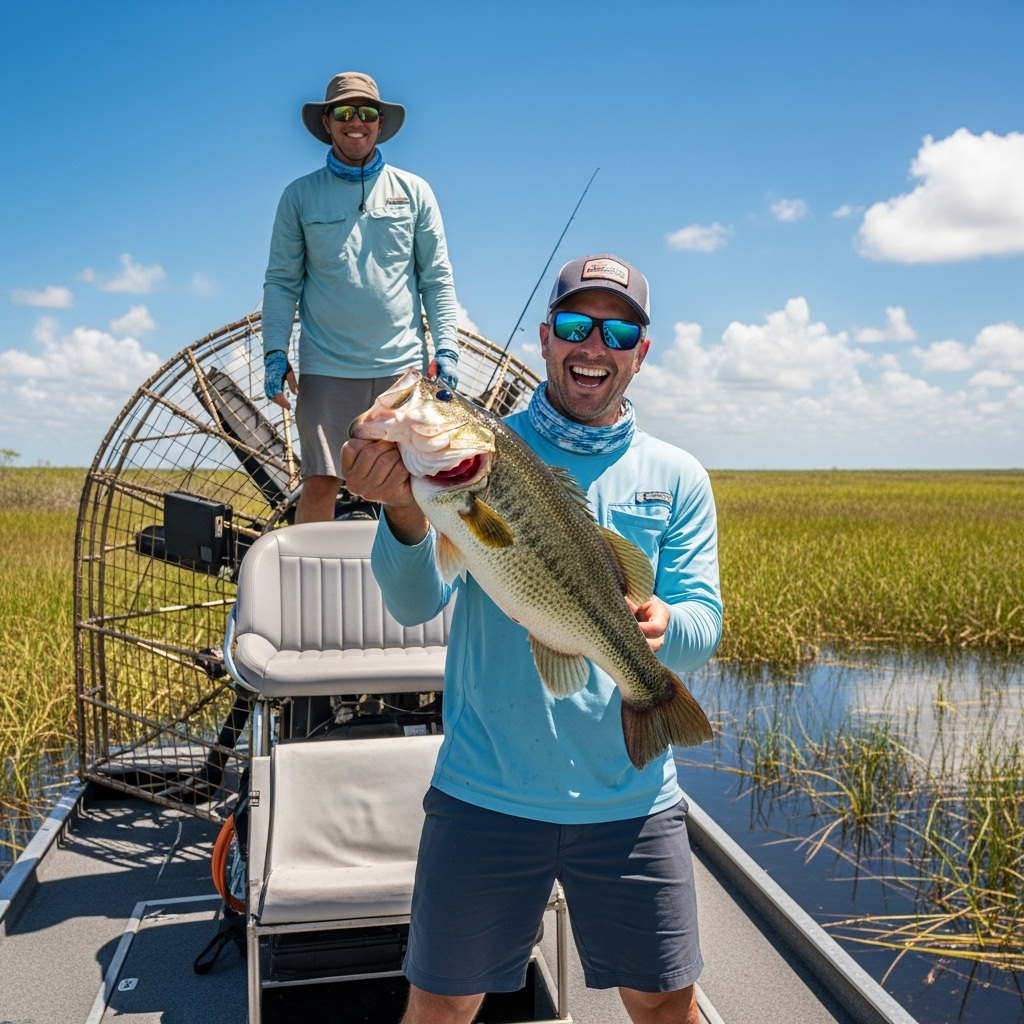
Airboat fishing charters near Steinhatchee and Lamont provide access to an environment that remains largely untouched. They combine the sport of fishing with the adventure of exploring areas inaccessible to most boats, while also offering flexible experiences for non-fishing guests. For those ready to immerse themselves in the marsh, connect with the Econfina’s hidden waters, and enjoy a guided day on the flats, book a trip with us and experience the Big Bend in its most authentic form.

